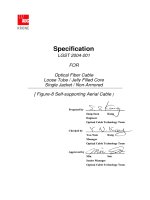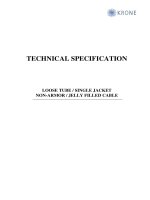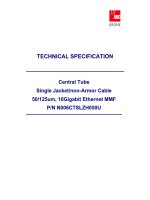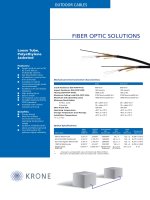Datasheet - FO - Cable - Outdoor, Armor, PE Jacketed
Bạn đang xem bản rút gọn của tài liệu. Xem và tải ngay bản đầy đủ của tài liệu tại đây (228.33 KB, 8 trang )
23
TECHNICAL SPECIFICATION
OPTICAL FIBRE CABLE
LOOSE TUBE / JELLY FILLED
DOUBLE JACKET / SINGLE ARMORED
(LTD ARM CABLE)
23
PAGE 2 OF 8
1. SCOPE
1.1 Application
This specification covers the general requirements for fiber optic telecommunication
cables used for inter-building backbone in duct, direct buried and lashed aerial installation.
1.2 Cable Description
1) Jelly Filled / Double Jacket / Single Armored Rodent Protected Cable
Single and 50 or 62.5 Multi mode color coded fibers, jelly filled color coded loose
tubes, PE filler (if required), water swellable yarn around the central strength member,
SZ-stranded around the dielectric CSM, water swellable tape, outer strength member,
inner PE jacket, water swellable tape, corrugated steel tape armor and outer PE jacket.
2. OPTICAL FIBER
The optical, geometrical and mechanical performance of the optical fiber shall be in
accordance with Table 1 and 2 below.
Table 1. The Optical, Geometrical and Mechanical Performance of the Multi Mode Fiber
SPECIFICATION
ITEMS UNITS
50 Multi Mode 62.5 Multi Mode
Attenuation dB/km
≤ 3.0 at 850nm
≤ 1.0 at 1300nm
≤ 3.5 at 850nm
≤ 1.0 at 1300nm
Bandwidth MHz.km
≥ 400 at 850nm
≥ 600 at 1300nm
≥ 200 at 850nm
≥ 400 at 1300nm
Numerical Aperture -
0.20±0.015 0.275±0.015
Core Diameter
µm
50±3.0 62.5±3.0
Core Non-circularity %
≤ 6.0 ≤ 6.0
Cladding Diameter
µm
125±2.0 125±2.0
Cladding Non-circularity %
≤ 2.0 ≤ 2.0
Core/Cladding Concentricity Error
µm
≤ 3.0 ≤ 3.0
Coating Diameter
µm
245±15 245±15
Proof Test Kpsi
≥ 100 ≥ 100
*Note) Superior performance available upon request.
23
PAGE 3 OF 8
Table 2. The Optical, Geometrical and Mechanical Performance of the Single Mode Fiber
ITEMS UNITS SPECIFICATION
Attenuation dB/km
≤ 0.4 at 1310nm
≤ 0.25 at 1550nm
Chromatic Dispersion ps/nm.km
≤ 3.2 at 1285nm ~ 1330nm
≤ 18 at 1550nm
Zero Dispersion Wavelength nm
1300 ~ 1324
Zero Dispersion Slope ps/nm
2
.km
≤ 0.093
Cut-off Wavelength
(λcc, 22m of a cabled fiber)
nm
≤ 1270
Mode Field Diameter
µm
9.3±1.0
Mode Field Concentricity
µm
≤ 0.8
Cladding Diameter
µm
125±1.0
Cladding Non-circularity %
≤ 1.0
Coating Diameter
µm
245±15
Proof Test Kpsi
≥ 100
*Note) Superior performance available upon request.
3. CABLE CONSTRUCTION
The construction of the cable shall be in accordance with Table 3 below.
Table 3. Construction of the Cable
ITEMS DESCRIPTION
Type of Fiber Single Mode or 62.5 Multi Mode or 50 Multi Mode
Number of Fibers 2 ~ 72
No. of Fibers per Tube Max. 12
Material PBT (Polybutylene Terephthalate) Loose Buffer
Tube
Diameter Nom. 2.4mm
Filling Compound
in Loose Buffer Tube
Thixotropic Jelly Compound
Material Polyethylene rods (Natural color) Filler
(if necessary)
Diameter Nom. 2.4mm
Central Strength Member FRP (Fiberglass Reinforced Plastic)
Water Blocking Material
Water Swellable Yarn around the CSM
(To prevent the water ingress into the cable core)
Core Wrapping Tape
Water Swellable Tape
(To prevent the water ingress into the cable core)
23
PAGE 4 OF 8
Table 3. Construction of the Cable(continued)
ITEMS DESCRIPTION
Outer Strength Member
Glass yarns
(To provide the required tensile strength together)
Ripcord
Two Ripcords
(To provide easy cable entry, approx. 180° separation)
Material Black HDPE or MDPE
Inner Jacket
Thickness Nom. 1.0mm, Min. 0.7mm
Water Blocking Material
Water Swellable Tape
(To prevent the ingress of water)
Ripcord
Two Ripcords
(To provide easy cable entry, approx. 180° separation)
Material Steel Tape with Plastic Coating on Both Sides
Armor
Thickness
Nom. 0.15mm (Steel Tape)
Nom. 0.05mm (Plastic Coating)
Material Black HDPE or MDPE
Outer Jacket
Thickness Nom. 1.5mm, Min. 1.2mm
4. FIBER AND LOOSE BUFFER TUBE IDENTIFICATION
The color code of the loose buffer tubes and the individual fibers within each loose buffer
tube shall be in accordance with Table 4 below.
Table 4. The Color Code of the Individual Fibers and Loose Tubes
No. Color No. Color
1 Blue 7 Red
2 Orange 8 Black
3 Green 9 Yellow
4 Brown 10 Violet
5 Gray 11 Pink
6 White 12 Aqua
23
PAGE 5 OF 8
5. PHYSICAL / MECHANICAL / ENVIRONMENTAL PERFORMANCE
The mechanical and environmental performance of the cable shall be in accordance with
Table 5 below. Unless otherwise specified, all attenuation measurements required in this
section shall be performed at 1550nm for single mode fiber (SM) and at 1300nm for multi
mode fiber (MM).
Table 5. The Mechanical and Environmental Performance of the Cable
ITEMS
TEST METHOD AND
ACCEPTANCE CRITERIA
Tensile Performance
# Test method: IEC 794-1-E1
-. Mandrel diameter: 30D (D = cable diameter)
-. Tensile load: 2,700N for 1 hour
# Acceptance Criteria
-. Fiber strain: ≤ 0.33%
-. Attenuation increment: ≤ 0.10 dB (SM)
≤ 0.20 dB (MM)
for long term tensile load
Crush
# Test method: IEC 794-1 Method E3
-. Applied load: 3500N/100mm
-. Duration of loading: 1 minute
# Acceptance Criteria
-. Attenuation Increment: ≤ 0.10 dB (SM)
≤ 0.20 dB (MM)
after completion of the test
Impact
# Test method: IEC 794-1 Method E4
-. Drop hammer mass: 1 kg
-. Height of impact: 1 m
-. Diameter of drop hammer: 25 mm
-. Radius impact surface: 300 mm
-. No. of impact per point: 1 time
-. No. of impact points: 5 points (500mm interval)
# Acceptance Criteria
-. No jacket cracking and fiber breakage
-. Attenuation Increment: ≤ 0.10 dB (SM)
≤ 0.20 dB (MM)
after completion of the test
Repeated Bending
# Test method: IEC 794-1 Method E6
-. Sheave diameter: 20D (D = cable diameter)
-. No. of flexing cycles: 30 cycles
-. Flexing speed: 30 cycles/minute
# Acceptance Criteria
-. No jacket cracking and fiber breakage
-. Attenuation Increment: ≤ 0.10 dB (SM)
≤ 0.20 dB (MM)
after completion of the test









